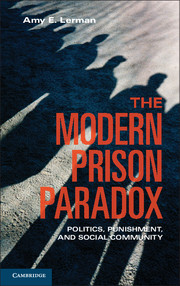Book contents
- Frontmatter
- Miscellaneous Frontmatter
- Contents
- Acknowledgments
- 1 The Modern Prison Paradox
- 2 Politics and the Punitive Turn
- 3 Public Policy and the Creation of Community
- 4 The Culture and Consequence of Prison
- 5 The Social Effects of Incarceration
- 6 The Social Effects of Prison Work
- 7 From Individuals to Communities
- 8 The Road to Reform
- 9 Epilogue (Or: How I Went to Berkeley and Wound Up in Prison)
- Appendixes
- Notes
- Index
6 - The Social Effects of Prison Work
Published online by Cambridge University Press: 05 June 2014
- Frontmatter
- Miscellaneous Frontmatter
- Contents
- Acknowledgments
- 1 The Modern Prison Paradox
- 2 Politics and the Punitive Turn
- 3 Public Policy and the Creation of Community
- 4 The Culture and Consequence of Prison
- 5 The Social Effects of Incarceration
- 6 The Social Effects of Prison Work
- 7 From Individuals to Communities
- 8 The Road to Reform
- 9 Epilogue (Or: How I Went to Berkeley and Wound Up in Prison)
- Appendixes
- Notes
- Index
Summary
You shall have joy, or you shall have power, said God; you shall not have both.
Ralph Waldo Emerson, Journals (1842)In the preceding chapter, I presented evidence that incarceration can create communities of inmates that are best described not as relations of “mutual aid, loyalty, affection, and respect” or as a “war of all against all,” but instead as a precarious combination of the two. As Gresham Sykes pointed out, describing the social dynamics of inmate life: “In actuality, the patterns of social interaction among inmates are to be found scattered between these two theoretical extremes. The population of prisoners does not exhibit a perfect solidarity yet neither is the population of prisoners a warring aggregate. Rather, it is a mixture of both and the society of captives lies balanced in an uneasy compromise.” The social effects of higher-security prisons, in particular, are marked by both solidarity and strife; inmates form strong social ties, but these groups serve as the basis for development of contentious and sometimes even violent inter-group norms. Thus, life for inmates within the prison setting may be experienced simultaneously as “predominantly cohesive” and as “a jungle-like existence.”
- Type
- Chapter
- Information
- The Modern Prison ParadoxPolitics, Punishment, and Social Community, pp. 123 - 149Publisher: Cambridge University PressPrint publication year: 2013



